Schedule Monthly Genre Science fiction Letterer(s) Jodi Wynne | Format Ongoing Publication date June 2013 Colorist(s) Santi Arcas | |
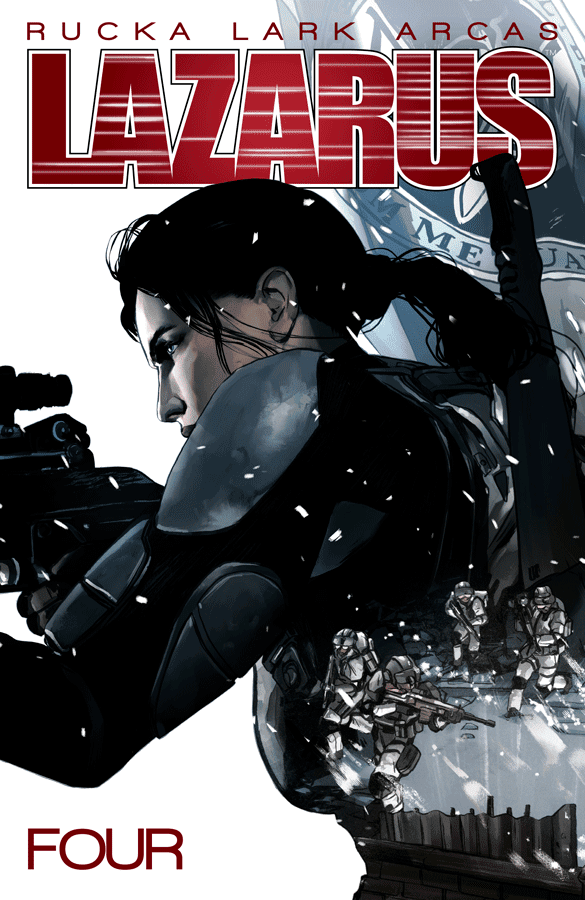 | ||
Similar Gotham Central, East of West, Queen & Country, Stumptown, The Fade Out | ||
Lazarus is a dystopian science fiction comic book series created by Greg Rucka and Michael Lark. Image Comics has published the book since the first issue was released on June 23, 2013.
Contents

In the series, the world is has been divided among sixteen families who run their territories in a feudal system. The main character is Forever Carlyle, who is the military leader for the Carlyle family. The series has received mostly positive reviews from critics who praise its world building.

Early development
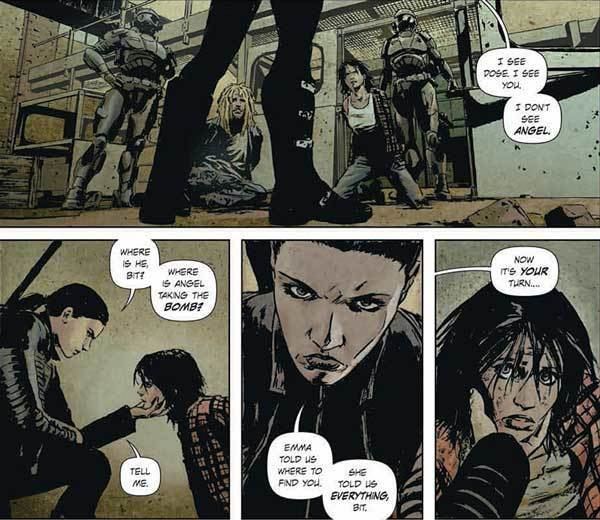
Rucka and Lark had previously collaborated on the comic series Gotham Central for DC Comics between 2002 and 2004 and various small projects for Marvel Comics in the years following. Lark wanted to work with Rucka on a creator-owned comic because he felt he was at his best drawing the kind of stories Rucka writes.
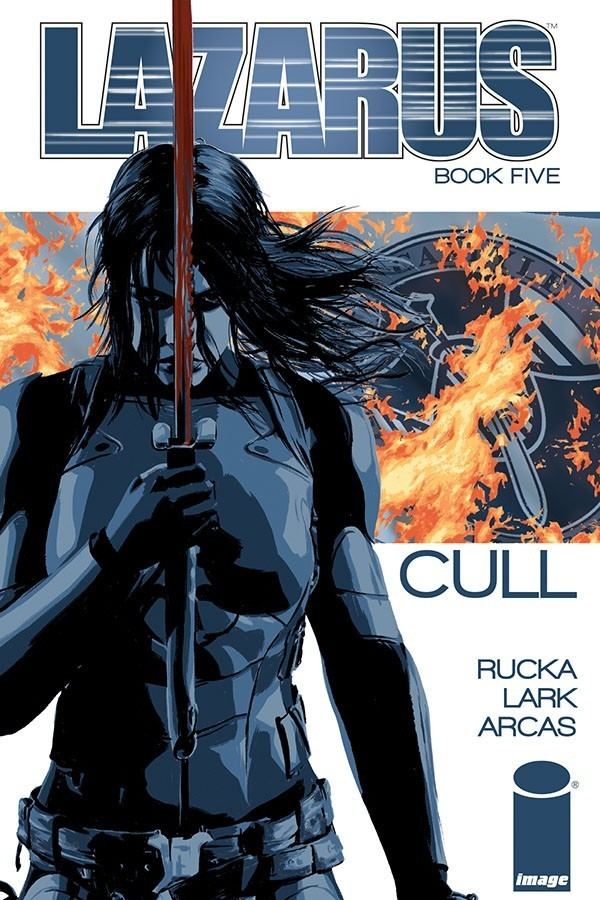
In June 2012, Rucka was in Dallas as part of a book-signing tour. He had dinner with Lark, who lived nearby, and shared an idea for a scene involving a woman who had been shot rising from the dead and pursuing her attackers. Lark liked the story and committed to drawing the comic as soon as a full script was ready. Although Rucka had previously published his creator-owned material through Oni Press, his friend Ed Brubaker had been pushing him to work with Image Comics. When they contacted Image's Eric Stephenson and pitched the project as "The Godfather meets Children of Men", he immediately expressed interest. The project, titled Lazarus, was officially announced at the San Diego Comic Con on July 14, 2012. The announcement was accompanied by promotional artwork colored by Elizabeth Breitweiser.

Image provided David Brothers to serve as the series' editor. Unlike traditional comic editors who focus on coordinating schedules and pushing deadlines, Brothers only reviews the work and provides responses that help the team create better work with more internal consistency. Eric Trautman, who had previously edited two of Rucka's novels, was recruited to help with research, timelines, and design work. Lark wanted to work with a European colorist to provide a look distinct from traditional American comics. Rucka suggested Santi Arcas, a colorist he had worked with in the past, and Lark particularly liked Arcas' skies and textures.
Production
Rucka and Lark developed the setting for Lazarus by looking at the Occupy movement and the underlying economics and asking themselves "What happens if it goes horribly wrong?" The main character was originally named Endeavor, but Rucka changed it to Forever to avoid a conflict with a different comic being developed at the same time about a young Inspector Morse. Her body type is based on the soccer player Hope Solo. The story's ending was planned before work began on the first issue.
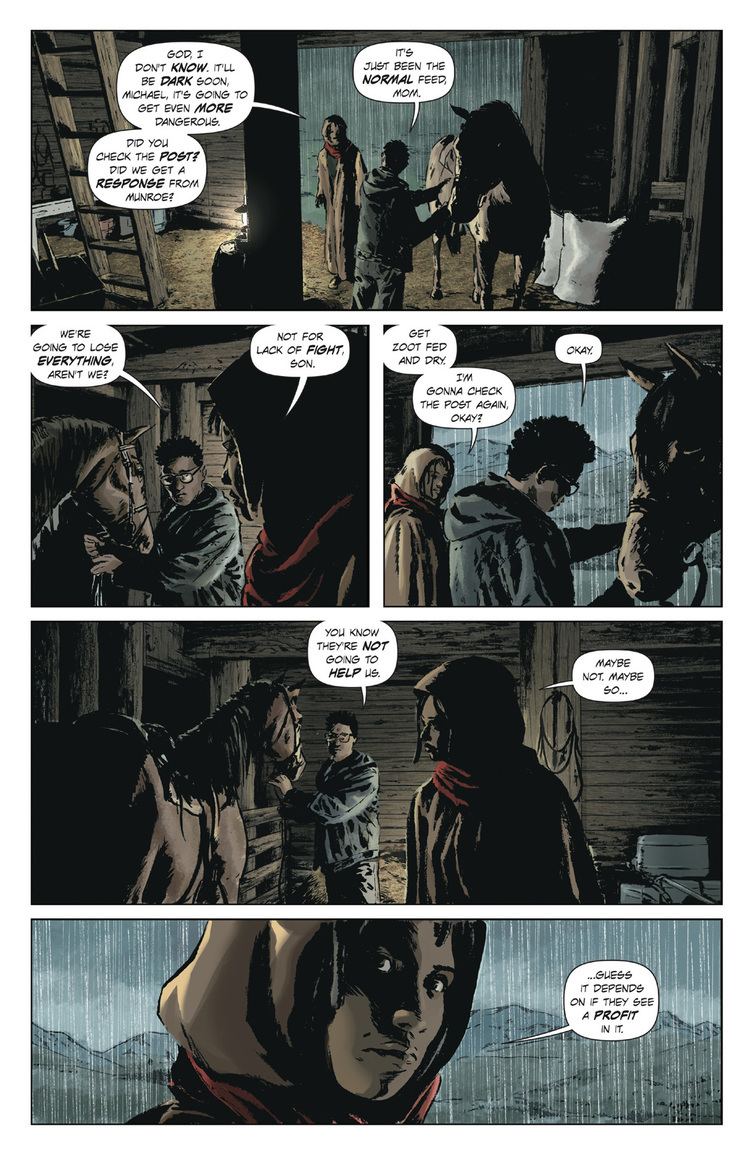
When Lark received the first script, he was disappointed. He felt none of the characters were likable, and the scene Rucka had described to him over dinner was not included. Rucka wrote a new draft to address Lark's concerns and restored the missing opening scene. Lark began drawing the first issue in January 2013 and based the opening scene on the birth sequence in The Fifth Element.
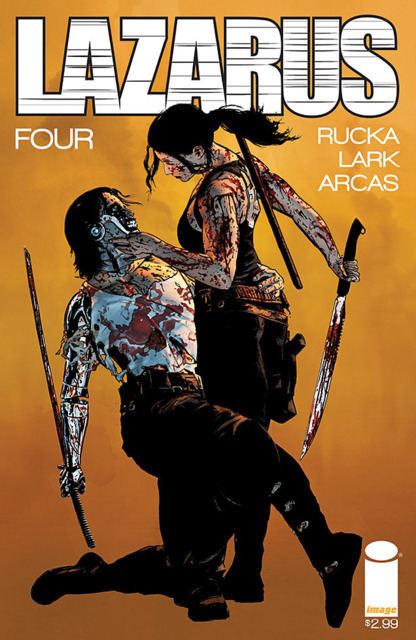
When writing a new script, Rucka tries to follow the world-building model used by William Gibson in Neuromancer and provide information about the environment through context instead of exposition. His biggest struggle is delivering details while maintaining a proper pace. He sometimes self-censors "exceptionally dark" material because he does not want to make Lark draw it. After Lark receives a new script, the collaboration between them is "immediate and constant". Lark questions Rucka about characterization and the direction of the story, resulting in rewrites and a better final product. Rucka says Lark intuitively knows what is happening in the story even when it isn't clearly scripted. Rucka and Lark have an ongoing conversation about how to show the injustice in the way Forever is treated without being complicit in it themselves. For example, medics must remove Forever's clothes to treat her wounds. Lark wanted to avoid sexualizing the images, but also avoid being "coy" by simply blocking parts of her body with another character's arm. The script gives Lark no direction for aspects like architecture, clothing, or vehicle design. Designing these technical details involves research into prototype technology and takes almost as long as drawing the actual pages for the comics. The time required to create the sets is the primary reason Lark sometimes falls behind schedule.
Lark works on Lazarus ten or more hours per day. He uses photo references and digital tools in the early stages of his art, but the layouts and drawing are done with traditional tools. He is also more involved with the coloring on Lazarus than any other comic he has done. Lark initially did the lettering and inking for Lazarus, but doing so made it impossible to release new issues on a regular schedule. To give him more time to focus on drawing, some of the smaller tasks like logo and type design were given to other people. Brian Level assisted with inking on issues three through ten, when he was replaced by Tyler Boss. Beginning with issue ten, Jodi Wynne took over the lettering duties and Owen Freeman started creating the cover art. Fake advertisements found on the back covers and many of the computer screens and holographic images in the artwork are created by Trautman. Lark and Rucka often discuss whether to use sound effects in scenes or limit their use. Lark does not want to rely on them to convey information because they may become a "crutch" in place of including important details in the art.
Issue fifteen features a silent fight between two characters that lasts thirteen pages. Rucka, who used to be a choreographer, filmed himself acting out the battle with a friend. Lark used the film for reference as he drew.
Publication
Brubaker advised Rucka to create a four-page "trailer" to promote the book, a strategy Brubaker had used with The Fade Out. Rucka was not initially interested, but Lark liked the idea. The trailer debuted at the 2013 Emerald City Comic Con before appearing online and in Previews, the catalog for Diamond Distribution. The scene was not reproduced in any issue of the series.
Most comics sold to specialty stores in the direct market are non-returnable. To reduce the financial risk for retailers who were uncertain about its sales potential, unsold copies from qualifying orders of the first three issues of Lazarus could be returned to the publisher. The first issue went on sale on June 26, 2013 and the 35,000 copy print run sold out at the distributor level within one day. A second printing was announced to coincide with the release of issue two. After a second sellout, it was included in the discounted "Image Firsts" line of first-issue reprints that are continuously available for retailers to order. By the end of 2013, the first issue had sold an estimated 50,200 copies. The second issue, which also went through multiple printings, sold an estimated 30,600 copies. Over the next two years, sales fell steadily to about 14,500 copies.
Because of scheduling issues, Rucka and Lark were behind on the series from the start. After several late issues, the team announced a four-month hiatus between issues 21 and 22 to allow Lark to get ahead of schedule. They said they would not solicit any additional issues until the next story arc was completed, and the hiatus actually lasted six months, in part because of miscommunication between Image Comics and Diamond Distribution. During the hiatus, they released a sourcebook providing additional, non-essential background on the Carlyle family. A second sourcebook detailing the Hock Family was scheduled for release in April 2017, during the delay between issues 25 and 26.
At the start of the series, Rucka estimated it would take between 100 and 150 issues to reach the ending. In May 2016, he revised that number downward, saying Lazarus was "25–30% complete at issue 21".
The series has been compiled in four trade paperbacks and two hardcovers. The hardcovers include introductions from notable comic creators like Warren Ellis and behind-the-scenes material not otherwise available. Rucka and Lark take the extra content in them "very seriously" because hardcovers are expensive. Rucka has said that while the sales of single issues "aren't great", the series is selling better in a collected format. In 2015, the first collection sold close to the same number of copies as it did in 2013, the year it was released.
Synopsis
Lazarus is a coming of age story for a young woman named Forever Carlyle who is questioning her identity. Its major themes are the meaning of "family" and nature versus nurture. It is set in a bleak future where the world has been divided into sixteen large land areas, each ruled by one family. Each family rules their region in a feudal system that divides people into three tiers: "family", "serfs" (skilled labors), and "waste". The families have formed alliances to protect themselves from other families, and each family has a chosen warrior known as a "Lazarus" who represents them in combat. Forever is the Lazarus for the Carlyle family. She obeys the family patriarch, Malcolm Carlyle. She has four siblings: Steven, Beth, and twins Jonah and Johanna. As of issue 25, their mother's whereabouts have not been revealed.
Plot
When Jonah and Johanna plot a coup against Malcolm, one of their first steps is to kill Forever. When she is returning from a diplomatic mission in Morray territory, Carlyle airships fire on Forever and the Morray lazarus. Neither are killed, and Forever is told by a pilot that Jonah sent them.
Critical reception
Lazarus has received positive reviews since its debut. According to review aggregator Comic Book Roundup, critics gave the first issue an average score of 8.7/10 based on 32 reviews. The series as a whole averages 8.6/10 based on 284 reviews. Critics and fans often praise the world-building in Lazarus, but Lark and Rucka see it as secondary and think it receives too much focus. Publishers Weekly said Forever's "fascinating complexity" made Lazarus stand out. Writing for Comics Alliance, KM Bezner said every character, including the diabolical ones, displayed humanity and "[blurred] the lines between shades of morality". On Broken Frontier, Tyler Chin-Tanner described 'Lift', the series' second story arc, as "a moving tale of family sacrifice". The series has appeared on many comic critics' "best of" lists.
It has been compared to Game of Thrones, but Rucka has not read the books and does not watch the show to avoid unintentionally borrowing ideas from it. Lark thinks the comparison works to some extent, but points out that Lazarus concentrates more on a single character. Garrett Martin wrote in Paste Magazine that Lazarus is unlike other recent class warfare genre fiction like Hunger Games or Blackacre because it is told from the oppressors' point of view.
Oliver Sava reviewed the series for The A.V. Club and said it stood out from Image's other science fiction comics "because it's more grounded in current political and economic trends". The Jersey Journal critic William Kulesa agreed, calling Lazarus a high quality sci-fi for its "deeply considered speculation on society, technology, and the future". Newsarama reviewer Vanessa Gabriel said it "engages the reader with plausibility". Chin-Tanner liked how Lazarus was a character driven story while it dealt with political and scientific issues. Because of its economic themes, Bezner said that there are political elements that will not be for everyone.
Behind the Panels reviewer Richard Gray felt the first issue did too little to set itself apart from similar books on the market. While Ana Grilo recommended the book for The Book Smugglers, she felt the disparity in numbers between the family, serf, and waste was too unstable to be plausible. Since the series debut, the pace has been a frequent point of criticism.
Lark was praised for being equally good at depicting violence and introspection, and Martin said it was Lark's finest work. The characters in Lazarus rarely say what they mean, and some vital story beats are depicted by wordless art. Lark's ability to convey Rucka's story without supporting text led Henry Chamberlain, a reviewer for Comics Grinder, to say "you can feel the chemistry" between them. Arcas received notice for adding texture and depth to Lark's art and using pallette changes to help tell the story.
Television adaptation
Legendary Television bought the rights to adapt Lazarus following a competitive bidding war in March 2015. Rucka and Lark will be executive producers along with David Manpearl and Matt Tolmach. A pilot script written by Rucka entered its final draft in late 2015 and Legendary began looking for a network willing to purchase it. During the hiatus between issues 21 and 22, Rucka and Lark were able to devote additional time to developing the adaptation. Rucka said the development process for Lazarus has been better than any of his previous Hollywood experiences, and that he hopes the show will be able to explore characters more deeply using scenes that were cut from the book.
